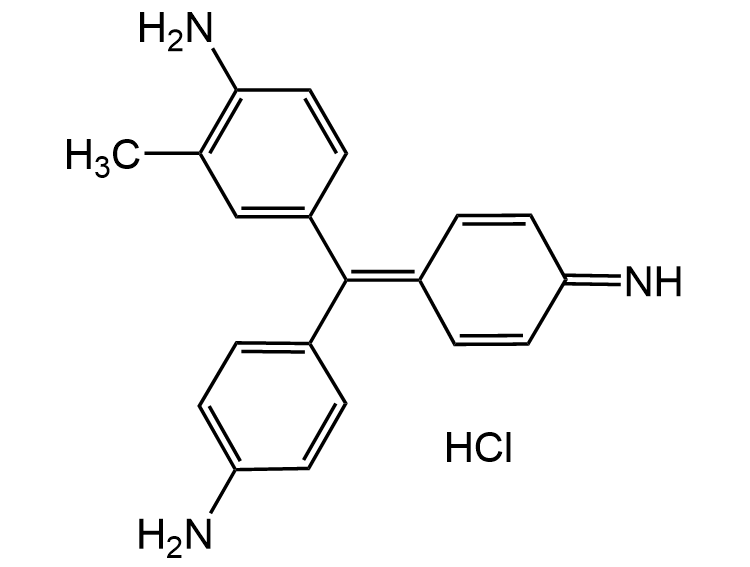Basic Fuchsin
Product Code:
CDX-F0102
CDX-F0102
Regulatory Status:
RUO
RUO
Shipping:
Ambient
Ambient
Storage:
Short term: +20°C. Long term: +20°C
Short term: +20°C. Long term: +20°C
No additional charges, what you see is what you pay! *
| Code | Size | Price |
|---|
| CDX-F0102-G025 | 25 g | £69.00 |
Quantity:
| CDX-F0102-G100 | 100 g | £156.00 |
Quantity:
Prices exclude any Taxes / VAT
Stay in control of your spending. These prices have no additional charges to UK mainland customers, not even shipping!
* Rare exceptions are clearly labelled (only 0.14% of items!).
* Rare exceptions are clearly labelled (only 0.14% of items!).
Multibuy discounts available! Contact us to find what you can save.
This product comes from: Switzerland.
Typical lead time: 7-10 working days.
Contact us for more accurate information.
Typical lead time: 7-10 working days.
Contact us for more accurate information.
- Further Information
- Documents
- References
- Show All
Further Information
Appearance:
Green powder.
CAS:
632-99-5 | 569-61-9
Description:
Basic Fuchsin is a triphenylmethane dye renowned for its intense magenta color. It is primarily used in microbiological and histological staining as it has a strong affinity for nucleic acids and cellular components, making it invaluable in the visualization of cell structures under a microscope. The mechanism of action of Basic Fuchsin involves its basic properties, which allow it to bind to acidic components of cells, particularly nucleic acids, through electrostatic interactions. In research, Basic Fuchsin is extensively used in the Gram staining procedure, a fundamental technique for bacterial classification and identification. In this process, it serves as a primary stain that colors all cells. However, its retention in Gram-positive bacteria, due to their thicker peptidoglycan layer, contrasts sharply with its removal from Gram-negative bacteria during a decolorization step, demonstrating its selective staining capabilities. Additionally, Basic Fuchsin is used in other histological stains, such as the Schiff reagent for the periodic acid-Schiff reaction, which is essential for identifying polysaccharides such as glycogen in tissues and is also used for staining of acid-fast bacteria (AFB). Through these applications, Basic Fuchsin continues to be a pivotal tool in both clinical diagnostics and biological research, providing critical insights into microbial morphology and cellular biochemistry.
EClass:
32160000
Form:
solid
GHS:
GHS08
Handling Advice:
Protect from light and moisture.
Hazards:
H351
InChi:
InChI=1S/C20H19N3.ClH/c1-13-12-16(6-11-19(13)23)20(14-2-7-17(21)8-3-14)15-4-9-18(22)10-5-15;/h2-12,21H,22-23H2,1H3;1H
InChi Key:
NIKFYOSELWJIOF-SVFFXJIWSA-N
MDL:
MFCD00012569
Molecular Formula:
C20H20ClN3
Molecular Weight:
337.85
Package Type:
Vial
Precautions:
P201-P308 + P313
Purity:
>80.0% (dye content)
Signal word:
Warning
SMILES:
NC1=C(C)C=C(/C(C2=CC=C(N)C=C2)=C3C=CC(C=C/3)=N)C=C1.Cl
Solubility:
Soluble in water, methanol or DMSO.
Source / Host:
Synthetic
Transportation:
Non-hazardous
UNSPSC Number:
41105331
Use & Stability:
Stable for at least 2 years after receipt when stored at RT.
Documents
References
(1) E. Adams; Stain Technol. 50, 227 (1975) | (2) D.K. Cooper; Histochem. J. 9, 285 (1977) | (3) K. Pihlman & E. Linder; Histochem. 79, 157 (1983) | (4) T.J. Beveridge; Biotech. Histochem. 76, 111 (2001) | (5) T. Frisch, et al.; Eur. Arch. Otorhinolaryngol. 258, 55 (2001) | (6) R. Coico, et al.; Curr. Protoc. Microbiol. Appendix 3-3C (2005) | (7) C. Gordon, et al.; Int. J. Tuberc. Lung. Dis. 13, 130 (2009) | (8) M. Chen, et al.; Bioanalysis 5, 1545 (2013) | (9) B. Pathrose, et al.; Spectrochim. Acta A Mol. Biomol. Spectrosc. 128, 522 (2014) | (10) B. Pathrose, et al.; J. Fluoresc. 24, 895 (2014)



